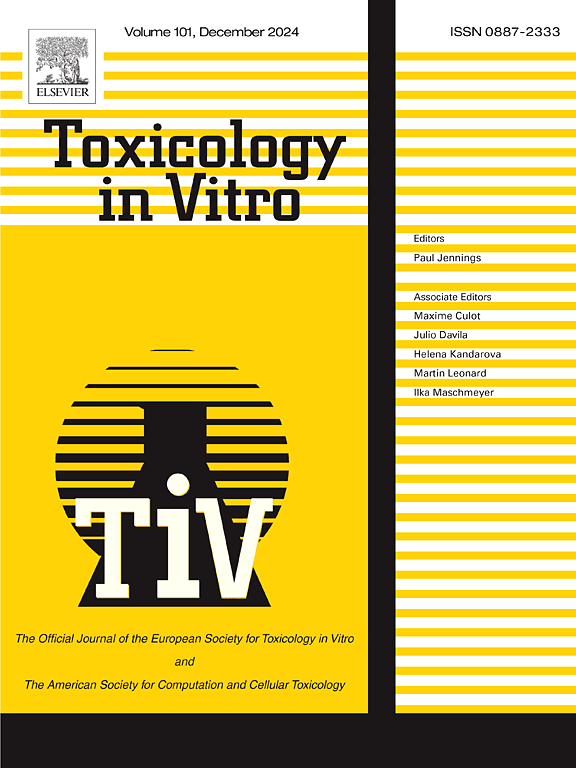将 MUTZ-Langerhans 细胞整合到三维全厚皮肤等效物中,以及减少血清用量和补充未确定的培养基对分化的影响。
IF 2.6
3区 医学
Q3 TOXICOLOGY
引用次数: 0
摘要
MUTZ-3 细胞系是一种替代朗格汉斯细胞(Langerhans cells,LCs)的细胞系,用于评估化学物质对皮肤的致敏潜力的新方法。然而,MUTZ-3 细胞必须首先进行分化,以获得 LC 典型表型。由于所有方案都使用高浓度的胎牛血清(FCS),我们的目标是在保持 MUTZ-LC 特性的同时减少甚至替代 FCS。此外,我们还评估了定义不清的 5637 条件培养基(5637CM)对 MUTZ-LC 分化的影响。将 FCS 含量降低 75%,7 天后而不是 14 天后就能达到理想的分化状态,CD207 和 CD1a 表达升高。用 Ultroser G(一种合成的 FCS 代用品)培养会导致 MUTZ-LC 数量不足。5 % FCS 分化的 MUTZ-LCs 可被 DNCB(一种极端敏化剂)激活,CD83 的表达增加就证明了这一点。5637CM 不会影响 MUTZ-LC 的分化,因此无需作为补充剂。为了让 MUTZ-LCs 在免疫功能正常的皮肤模型中发挥预期作用,以评估化学物质的致敏潜力,MUTZ-LCs 成功地融入了 Phenion® 全厚皮肤模型,CD1a 的表达证明了这一点。这些结果是根据 3R 原则实现培养基标准化和生成免疫功能健全皮肤模型的重要步骤。本文章由计算机程序翻译,如有差异,请以英文原文为准。
Integration of MUTZ-Langerhans cells into a 3D full-thickness skin equivalent and influences of serum reduction and undefined medium supplements on differentiation
The MUTZ-3 cell line is a surrogate for Langerhans cells (LCs) employed in New Approach Methodologies for assessing the skin sensitizing potential of chemicals. However, MUTZ-3 cells must first be differentiated to achieve the LC-typical phenotype. As all protocols use high fetal calf serum (FCS) concentrations, we aimed at reducing, or even replacing FCS, while maintaining MUTZ-LC characteristics. Additionally, we assessed the impact of the poorly defined 5637-conditioned medium (5637CM) on MUTZ-LC differentiation.
With reducing the FCS content by 75 %, the desired differentiation status was achieved after 7 instead of 14 days, identified by elevated CD207 and CD1a expression. Culture with Ultroser G, a synthetic surrogate for FCS, resulted in an insufficient number of MUTZ-LCs. 5 % FCS-differentiated MUTZ-LCs could be activated with DNCB, an extreme sensitizer, as demonstrated by increased CD83 expression. 5637CM did not affect MUTZ-LC differentiation and is therefore not needed as a supplement.
For their intended role in an immunocompetent skin model to assess the sensitizing potential of chemicals, MUTZ-LCs were successfully integrated into the Phenion® Full-Thickness skin model, as demonstrated by CD1a expression. These results are important steps towards medium standardization and the generation of an immunocompetent skin model according to the 3R principles.
求助全文
通过发布文献求助,成功后即可免费获取论文全文。
去求助
来源期刊

Toxicology in Vitro
医学-毒理学
CiteScore
6.50
自引率
3.10%
发文量
181
审稿时长
65 days
期刊介绍:
Toxicology in Vitro publishes original research papers and reviews on the application and use of in vitro systems for assessing or predicting the toxic effects of chemicals and elucidating their mechanisms of action. These in vitro techniques include utilizing cell or tissue cultures, isolated cells, tissue slices, subcellular fractions, transgenic cell cultures, and cells from transgenic organisms, as well as in silico modelling. The Journal will focus on investigations that involve the development and validation of new in vitro methods, e.g. for prediction of toxic effects based on traditional and in silico modelling; on the use of methods in high-throughput toxicology and pharmacology; elucidation of mechanisms of toxic action; the application of genomics, transcriptomics and proteomics in toxicology, as well as on comparative studies that characterise the relationship between in vitro and in vivo findings. The Journal strongly encourages the submission of manuscripts that focus on the development of in vitro methods, their practical applications and regulatory use (e.g. in the areas of food components cosmetics, pharmaceuticals, pesticides, and industrial chemicals). Toxicology in Vitro discourages papers that record reporting on toxicological effects from materials, such as plant extracts or herbal medicines, that have not been chemically characterized.
 求助内容:
求助内容: 应助结果提醒方式:
应助结果提醒方式:


